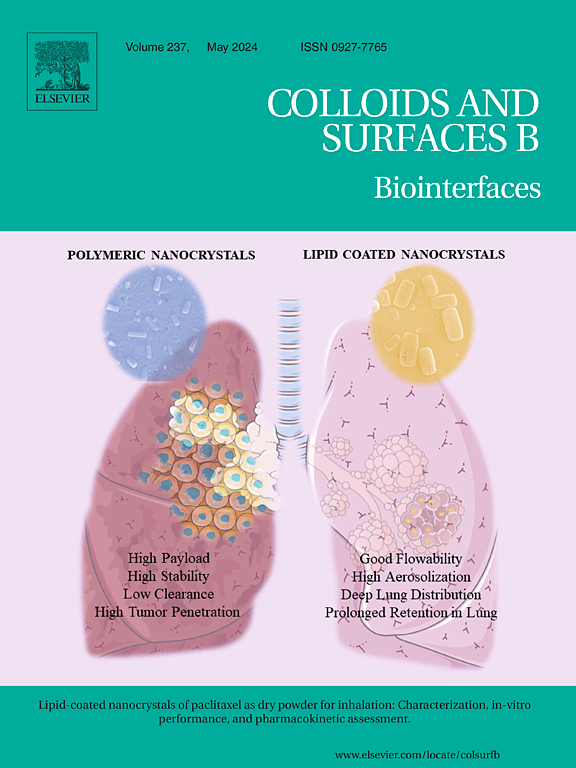通过巨噬细胞膜掩蔽脂质体逆转乳腺癌靶向治疗和多柔比星多药耐药性
IF 5.6
2区 医学
Q1 BIOPHYSICS
引用次数: 0
摘要
药物治疗是乳腺癌的主要治疗方法。然而,许多患者会产生多药耐药性(MDR),从而使治疗复杂化并降低疗效。为了解决这个问题,我们开发了一种新方法,将化疗药物多柔比星(DOX)和MDR逆转剂四氢蒽醌(Tet)结合在覆盖有巨噬细胞膜的可降解脂质体中,制成MM@DOX-Tet纳米颗粒(NPs)。这些纳米粒子能有效逆转乳腺癌细胞的MDR,与DOX-Tet混合物相比,MM@DOX-Tet纳米粒子的MDR增加了8倍,与单独的DOX-Tet纳米粒子相比,MM@DOX-Tet纳米粒子的MDR增加了3倍。经巨噬细胞膜修饰后,这些 NPs 可增强肿瘤靶向性和细胞摄取,从而显著降低癌细胞存活率。在动物实验中,MM@DOX-Tet NPs 的效果优于单一疗法和传统疗法,能有效靶向肿瘤并抑制肿瘤生长。此外,双层封装可防止药物泄漏,增加药物在肿瘤部位的蓄积。我们的研究将 MM@DOX-Tet NPs 作为一种潜在的纳米药物系统,用于克服乳腺癌治疗过程中的 MDR。本文章由计算机程序翻译,如有差异,请以英文原文为准。
Breast cancer-targeted therapy and doxorubicin multidrug resistance are reversed via macrophage membrane-camouflaged liposomes
Medication therapy is the primary treatment for breast cancer. However, many patients develop multidrug resistance (MDR), which complicates treatment and reduces its effectiveness. To address this, a novel approach was developed by combining the chemotherapeutic drug, doxorubicin (DOX), and the MDR reversal agent, tetrandrine (Tet), within degradable liposomes covered with macrophage membranes to create MM@DOX-Tet nanoparticles (NPs). These NPs effectively reversed MDR in breast cancer cells, with an eight-fold increase compared to a DOX-Tet mixture and a three-fold increase compared to DOX-Tet NPs alone. When modified with macrophage membranes, these NPs enhance tumor targeting and cell uptake, thereby significantly reducing cancer cell viability. In animal studies, MM@DOX-Tet NPs outperformed single and conventional therapies, efficiently targeted tumors, and suppressed tumor growth. Furthermore, dual-layer encapsulation prevents drug leakage and increases drug accumulation at the tumor sites. Our study introduces MM@DOX-Tet NPs as a potential nano-drug system for overcoming MDR during breast cancer treatment.
求助全文
通过发布文献求助,成功后即可免费获取论文全文。
去求助
来源期刊

Colloids and Surfaces B: Biointerfaces
生物-材料科学:生物材料
CiteScore
11.10
自引率
3.40%
发文量
730
审稿时长
42 days
期刊介绍:
Colloids and Surfaces B: Biointerfaces is an international journal devoted to fundamental and applied research on colloid and interfacial phenomena in relation to systems of biological origin, having particular relevance to the medical, pharmaceutical, biotechnological, food and cosmetic fields.
Submissions that: (1) deal solely with biological phenomena and do not describe the physico-chemical or colloid-chemical background and/or mechanism of the phenomena, and (2) deal solely with colloid/interfacial phenomena and do not have appropriate biological content or relevance, are outside the scope of the journal and will not be considered for publication.
The journal publishes regular research papers, reviews, short communications and invited perspective articles, called BioInterface Perspectives. The BioInterface Perspective provide researchers the opportunity to review their own work, as well as provide insight into the work of others that inspired and influenced the author. Regular articles should have a maximum total length of 6,000 words. In addition, a (combined) maximum of 8 normal-sized figures and/or tables is allowed (so for instance 3 tables and 5 figures). For multiple-panel figures each set of two panels equates to one figure. Short communications should not exceed half of the above. It is required to give on the article cover page a short statistical summary of the article listing the total number of words and tables/figures.
 求助内容:
求助内容: 应助结果提醒方式:
应助结果提醒方式:


